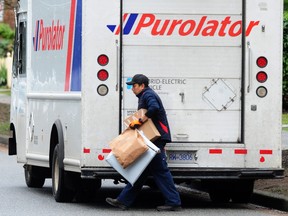Metro Vancouver can take lessons from Paris and Singapore on how to better use land and reduce road congestion in serving e-commerce.

Metro Vancouver’s municipalities need to start taking steps to loosen the squeeze that the demands of e-commerce are putting on the region, according to a new report commissioned for the regional district’s planning committee.
Steps as simple as creating municipality-wide inventories of loading zones, curbs and congestion points to gather data, then designating delivery areas near high-density housing to ease street congestion would be places to start, according to a staff summary of the report.
Start your day with a roundup of B.C.-focused news and opinion delivered straight to your inbox at 7 a.m., Monday to Friday.
Thanks for signing up!
A welcome email is on its way. If you don't see it, please check your junk folder.
The next issue of Sunrise presented by Vancouver Sun will soon be in your inbox.
Metro Vancouver tasked commercial realtor Colliers’ strategy and consulting group to conduct the research, which is being presented to the regional district planning committee’s Feb. 10 meeting
Metro’s member municipalities also need to consider more flexible zoning to accommodate emerging trends in e-commerce needs, while retaining primary land-use goals, but they can also learn from other cities and regions suffering through the ever-growing needs of e-commerce.
“There are a lot of lessons that can be learned there,” said Susan Thompson, associate director of research for Colliers. “Because if we’re limited on being able to expand further inland, because we’ve got an ocean on one side, the mountains, we’ve got the Agricultural Land Reserve, we can’t make more land.”
She added that the “absolute scarcity” of industrial land, which has had a less-than-one-per-cent vacancy rate over the last two years, driven by high demand for e-commerce is the biggest way the region is being squeezed.
“So how do we better utilize the land we have,” Thompson said.
In Paris, for instance, authorities zone logistic services as “facilities necessary for public service,” not just industrial or commercial, which allows for so-called logistics hotels next to rail lines or highways.
These are purpose-built hubs for several companies to use in sorting and consolidating deliveries by smaller often electric vehicles, which have helped the city to reduce freight-related vehicle emissions by 50 per cent.
“You get into things like densification and going vertical,” Thompson said. “Going vertical is a lesson we’ve learned from going around the world, particularly in Asia.”
In Singapore, for example, its port used revenue driven by the expansion of e-commerce to support spending on new technology to handle more shipping containers in far less space than the Port of Vancouver, cutting down on supply chain delays.
How to protect and best use industrial land has long been a concern for Metro Vancouver, which had just completed an industrial-land strategy complete with prioritized recommendations on how to better use that land in 2020, mostly before the COVID pandemic hit, said Eric Aderneck, senior planner for Metro Vancouver.
“So, we didn’t precisely foresee COVID and the rapid acceleration of e-commerce at the time,” Aderneck said. “But noting what’s been very obvious for the last couple of years, we decided to make that an action item for 2022.”
Aderneck said Colliers’ first recommendation, to gather more data to help better understand how the region’s curb sides are being used, isn’t necessarily straightforward.
“It’s not just for deliveries, bike lanes and parking,” Aderneck said. A substantial amount of commerce is being carried in the personal vehicles of gig-working ride-hailing drivers, not couriers, which is harder for municipalities to track.
“(Curb side) is an in-demand space, so it seems like everybody is trying to use it, sometimes at the same time,” Aderneck said.
Metro Vancouver’s planning committee will receive the report Friday and consider a recommendation that Metro Vancouver’s board adopt it as guidance, but Aderneck said adopting its recommendations will be up to the regional district’s municipalities.
However, Thompson said there are risks involved in not taking any action that reduces the e-commerce squeeze and improve the availability of industrial land for other users.
“Obviously, we could start to lose industrial users to other markets well outside of Metro Vancouver or even B.C.,” Thompson said. “And then you run the risk of stagnating growth locally.”
depenner@postmedia.com
twitter.com/derrickpenner
Support our journalism: Our in-depth journalism is possible thanks to the support of our subscribers. For just $3.50 per week, you can get unlimited, ad-lite access to The Vancouver Sun, The Province, National Post and 13 other Canadian news sites. Support us by subscribing today: The Vancouver Sun | The Province.


